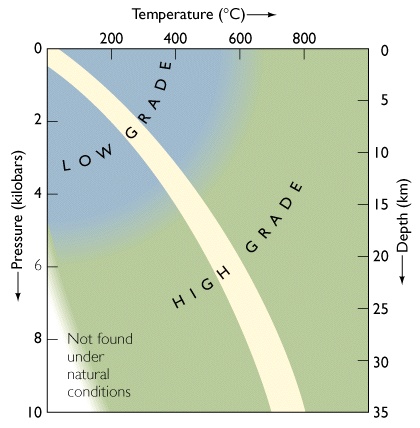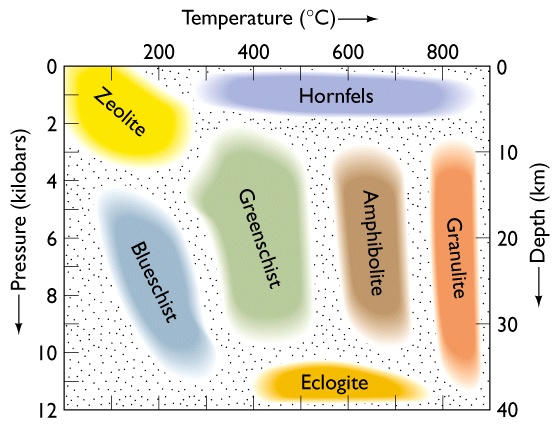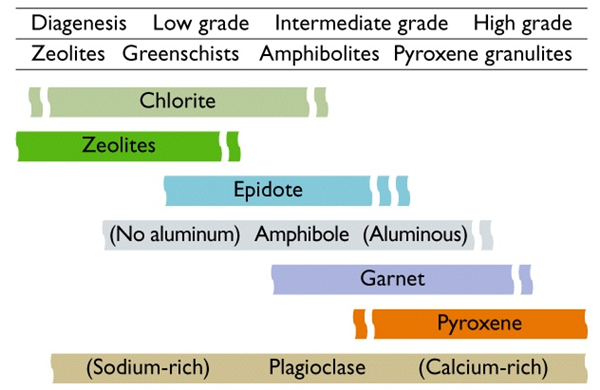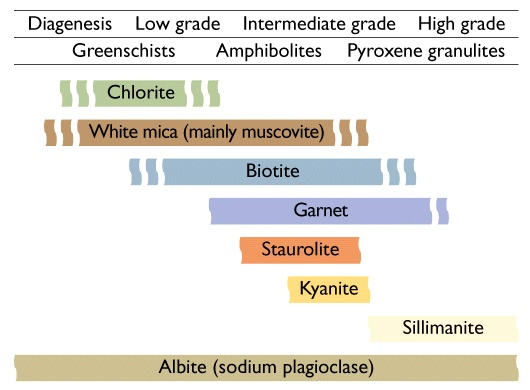Part A
Types of Metamorphism
There are many different types of metamorphism, but almost all occur at depth within the Earth. Metamorphic processes begin sometime after sedimentary burial and can continue until a rock's melting point is reached. Changes that occur during metamorphism occur while the rock is solid (no melting occurs). Increasing temperatures will progressively recrystallize the minerals, and make the new rock harder and denser than the original rock. Based on the degree or intensity of metamorphism (metamorphic grade), various elements will be rearranged and new minerals will form. Metamorphic conditions are typically shown on pressure-temperature (P-T) diagrams (Figure 8-2). The degree or intensity of metamorphism can range from low grade (low temperatures and/or pressures) to high grade (high temperatures) up until a point where the rock starts to melt (and becomes magma). The different areas of "P-T space" are called metamorphic facies (e.g., greenschist facies, amphibolite facies, etc.).
|
|
|
|
Figure 8-2. Metamorphic P-T diagrams. Metamorphic grade is a function of temperature and/or pressure (left). |
|
The Main Types of Metamorphism
There are different types of metamorphic environments depending on the metamorphic grade. The general types of metamorphism include:
Diagenesis
> Very low temperature and pressure metamorphism (a.k.a. burial metamorphism). Includes the zeolite facies in Figure 8-2.
> Occurs after sedimentary burial and before or during lithification.
Regional
> Variable low to high temperature and pressure metamorphism. Includes the greenschist, amphibolite, granulite, and eclogite facies in Figure 8-2.
> Fluid activity (mainly water) is also an important factor in regional metamorphism.
> Directed pressures![]() and fluid activity cause platy minerals (biotite, muscovite, etc.) in a rock to RE-ALIGN in a more parallel orientation, forming a layered or foliated metamorphic rock texture. Rocks lacking abundant amounts of platy minerals will not form a well developed foliation, even if they are subjected to intense pressure
and fluid activity cause platy minerals (biotite, muscovite, etc.) in a rock to RE-ALIGN in a more parallel orientation, forming a layered or foliated metamorphic rock texture. Rocks lacking abundant amounts of platy minerals will not form a well developed foliation, even if they are subjected to intense pressure
> Widespread metamorphic effects are associated with tectonically active areas, especially subduction zones.
Contact (thermal)
> High temperature and low pressure metamorphism. Includes the hornfels facies in Figure 8-2.
> Fluid activity (mainly water) is also an important factor in contact metamorphism, eventually grading into hydrothermal metamorphism.
> Since directed pressure is not a major factor in this type of metamorphism, resulting metamorphic rock types have randomly oriented crystals and thus have textures that are massive or non-foliated.
> High-temperature mineral RECRYSTALLIZATION occurs along mineral grain boundaries.
> Common near igneous intrusions. The metamorphic zone around an intrusion is referred to as a CONTACT AUREOLE or a "bake zone". The size of the aureole depend on the volume of the heat-generating intrusion, fluid activity, etc., but the effects are typically more localized than regional metamorphism.
> Magma-driven hydrothermal fluid activity is commonly associated with contact metamorphism.
Blueschist
> High pressure and low temperature metamorphism. Includes the blueschist facies in Figure 8-2.
> Eventually grades into greenschist metamorphism (a type of regional metamorphism) as temperatures rise.
> Occurs during rapid tectonic burial at subduction zones.
Dynamic
> Localized high temperatures and pressures related to fault zones and shear zones.
> Brittle deformation (crushing, grinding) includes cataclastic metamorphism that produces fault gouge and fault breccia.
> Ductile deformation (flow) occurs deeper within the crust and produces finely layered rocks called mylonites.
Impact
> Related to the localized, but very high pressures associated with asteroid/comet impacts.
> Rocks can be shattered and contain high-pressure minerals (stishovite, coesite, etc.).
Protoliths & Index Minerals
Metamorphic rocks are formed from a pre-existing igneous, metamorphic, or sedimentary rock. The original rock is referred to as parent rock or protolith . For instance, if limestone (parent rock) is buried and exposed to high temperatures, it will form a new rock called marble (metamorphic rock). And sometimes, we can still identify the original parent rock, so the prefix "meta" is commonly added to the protolith name (e.g., metaconglomerate).
Depending on the metamorphic grade and composition of the rock undergoing metamorphism, different minerals may grow as the metamorphic conditions change (see Figure 8-3). Index minerals are new minerals that form only under certain pressure-temperature conditions, so are great indicators of the metamorphism experienced by a rock. For example, a mudstone protolith will first yield the micas (chlorite, muscovite, biotite), and then garnet, staurolite, kyanite, and sillimanite. Different minerals (like amphibole) will form from a basaltic protolith. These minerals are great clues that help us interpret the nature and history of metamorphism of a rock or region.
|
|
|
|
Figure 8-3. Different protoliths and metamorphic grades generate a variety of metamorphic index minerals. Index minerals formed from a mudstone protolith (left) and a basaltic protolith (right). |
|
Use information from Figures 8-2 and 8-3 to answer the following questions.
![]()
![]()
![]()
![]()
![]()
![]()
![]()
![]()



